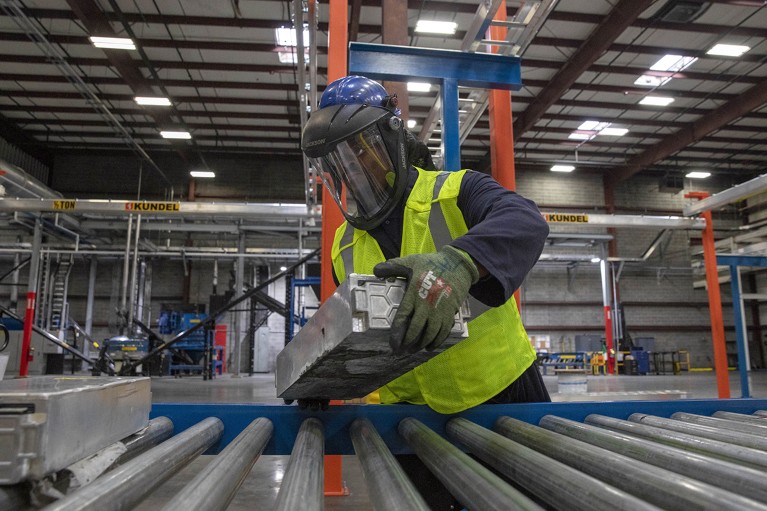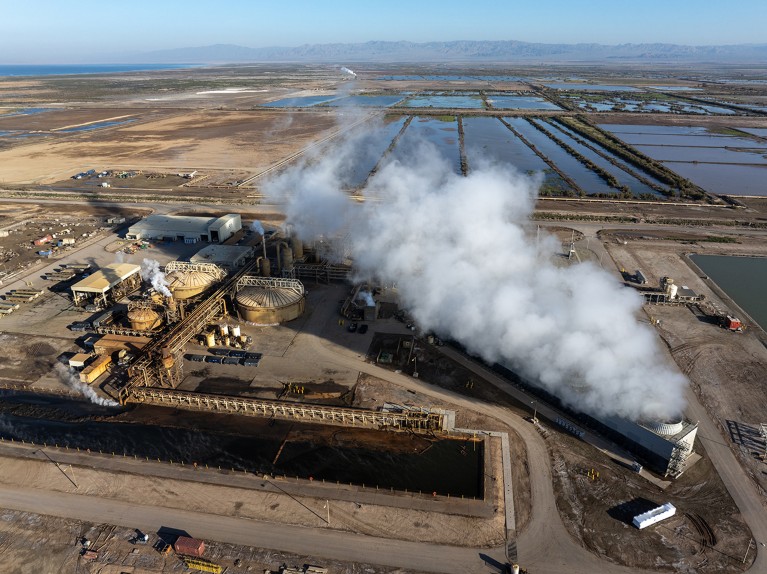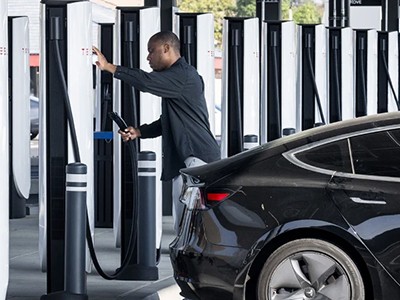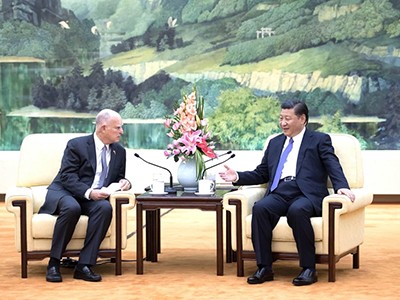Donald Trump’s imminent return as US president — this time hand in hand with electric-car tycoon Elon Musk — looks likely to reshape the global industries for electric vehicles and batteries. The United States is expected to escalate restrictions on imports of these technologies from China to protect its automotive industry. But Trump’s policy aims go further.
The proposed repeal of the 2022 Inflation Reduction Act (IRA) and the potential imposition of tariffs on Chinese electric vehicles (EVs) and batteries signal a strategic US effort to limit the increasing dominance of Chinese firms in the EV market. The United States has long led the global automotive sector, and is now resisting the erosion of its technological and economic leadership.
Three types of measure have been proposed: economic sanctions, export controls and domestic tax laws involving subsidies or tariffs aimed at specific countries. The question is, will these strategies work? The short answer seems to be no — or at least not in the intended ways.
The new car batteries that could power the electric vehicle revolution
Targeted countries can develop strategies to mitigate the effects of these policies, such as fostering domestic innovation, seeking alternative trade partnerships or strengthening economic self-reliance. Therefore, steps taken by the United States might actually drive, rather than hinder, Chinese innovation.
Similarly, subsidies and tariffs offer short-term protection but fail to address structural issues such as outdated infrastructure and skills gaps. Over time, such protectionist measures risk fragmenting global supply chains and straining alliances, undermining the measures’ long-term effectiveness.
What can researchers do? Numerous studies have shown that economic sanctions and export controls are often ineffective1,2. Yet, there is scant research on the consequences of subsidy or tax-related measures targeting sanctioned countries such as China.
The existing evidence is mixed, and needs unpacking. For instance, under the IRA, the United States has struggled with allocating its resources efficiently and securing crucial supply chains, and has relied too much on market incentives, which has slowed the transition to cleaner energy sources3. There is little analysis so far, however, on whether the IRA’s provisions have had a tangible impact on China’s EV and renewable-energy markets, its ability to compete internationally or its domestic industrial policies.
Researchers need to step up, for example, by learning how Chinese companies are doubling down on innovation and cost competitiveness. Understanding these responses would help policymakers and researchers to assess the broader global implications of the IRA, identify unintended consequences and refine strategies for managing economic competition.
To show what’s happening, here we examine two key US measures aimed at countering China: Section 301 of the 1974 Trade Act, and the IRA. And we propose strategies for how other countries can navigate the intensifying rivalry between the two global powers.
Two laws
In 2018, the previous Trump administration imposed a 27.5% tariff on passenger vehicles, including EVs, imported from China, under Section 301 of the Trade Act (see go.nature.com/4itd88a). The administration of President Joe Biden expanded these measures, raising tariffs on Chinese-made EVs from 25% to 100% in 2024. Furthermore, tariffs on EV batteries and battery components, which typically account for 30% of EV-production costs, were increased from 7.5% to 25% (see go.nature.com/3zmlp6v).
The United States is also leveraging the IRA to weaken the competitiveness of Chinese EVs in the US market. The IRA, which came into effect in August 2022, provides tax credits to US purchasers and EV producers (see go.nature.com/49xytoq). These measures are designed to boost domestic production and reduce dependence on China.

Battery recycling in Covington, Georgia.Credit: Alyssa Pointer for The Washington Post via Getty
Under the IRA, tax credits of up to US$7,500 are available to consumers purchasing EVs assembled in North America. These credits are divided into two parts, each worth $3,750: one for EVs with ‘critical minerals’ (such as lithium used in batteries) sourced from the United States or countries with which it has a free-trade agreement, and another for EVs that have a specified proportion of battery components that are domestically manufactured or assembled. Vehicles equipped with Chinese batteries or minerals are excluded.
US producers can also receive tax credits for manufacturing batteries and EVs domestically — for example, $35 per kilowatt-hour for battery cells and $10 per kWh for battery modules. Further incentives are available for producers that manufacture EVs domestically or source key materials for battery production locally or from approved trade partners.
How to spend one trillion dollars: the US decarbonization conundrum
It remains unclear whether these two policies have inflicted damage on Chinese firms. But it is already evident that Chinese EV and battery companies and the Chinese government are devising strategies to circumvent these measures, highlighting the potential inefficacy of these restrictions.
First, Chinese EV and battery manufacturers are establishing production bases in regions that allow them to bypass US tariffs and access IRA subsidies. For instance, Chinese automotive firm BYD’s planned production plant in Mexico will take advantage of the US–Mexico–Canada trade agreement, avoiding duties on China-made vehicles and facilitating access to EV markets across North and South America (see go.nature.com/4f9zhfz).
Furthermore, several Chinese battery-material and cell producers are investing in Morocco, which has a free-trade agreement with the United States, to meet IRA requirements for tax incentives and subsidies. Morocco’s role as an automotive hub has also attracted joint ventures between Chinese manufacturers and companies from South Korea (LG Chem with Huayou Cobalt) and Germany (BMW with Gotion High-Tech). This trend signifies a strategic shift, as companies leverage trade agreements to expand their presence in the global EV market (see go.nature.com/3daupcp).
Second, Chinese EV-battery companies are seeking to enter the US market through direct collaborations with US firms. For instance, in July 2022, Chinese battery manufacturer CATL pursued a partnership with US automobile manufacturer Ford, enabling EV production in the United States using CATL’s battery technology. This collaboration qualified Ford for IRA tax credits, because the batteries were manufactured domestically rather than being imported as Chinese-made batteries. However, this partnership was halted in September 2023 after criticism from US Republican senators, who cited concerns over national security and economic implications.
How provinces and cities can sustain US–China climate cooperation
CATL is now exploring entry into the US market through licensing agreements. These involve a company licensing its technology or intellectual property to another entity in exchange for royalties. Through this, CATL can provide its battery technology without owning or operating manufacturing facilities in the United States. For example, CATL plans to license its battery-cell technology to Japanese electronics company TDK, which will use it in a joint factory with US automobile firm General Motors (GM). This partnership will proceed without any direct equity sharing with GM (see go.nature.com/49aoohi).
This arrangement benefits all parties involved. GM gains access to advanced and cost-efficient Chinese battery technology and remains eligible for IRA tax credits; TDK acquires valuable battery-production expertise; and CATL secures a foothold in the US market.
Although these strategies seem to be working well for now, they also bring risks, such as higher costs and the tightening and expansion of US rules in the future. To stay competitive in the long run, Chinese companies will need to react quickly to such changes, build global networks and improve their technologies. And, as the global trade landscape changes as a result, other nations must adapt how they do business, too.
Three priorities
This reality suggests three priorities for EV and battery companies, governments and the international community.
Strengthen ties with the United States. Battery and EV companies outside China must strengthen their government relations and commercial ties with the United States. They will need to deploy tactics similar to those used by Chinese companies to establish themselves in the US market.
The rationale is clear: gain an early foothold in the US market and achieve long-term profitability. The United States has one of the largest EV markets globally, and leveraging tax credits allows global companies to secure an early market share. By turning US domestic-production incentives into opportunities, these companies can enhance their position against competitors such as China and establish themselves as leaders in green technologies, helping to fulfil climate-change goals.
Global companies should participate in US policy discussions to ensure that their businesses are not listed as entities under sanction. They are at risk of being affected owing to their dependencies on Chinese raw materials for battery cells, which can disqualify them from IRA tax credits.

The United States is expanding domestic lithium production for batteries.Credit: David McNew/Getty




